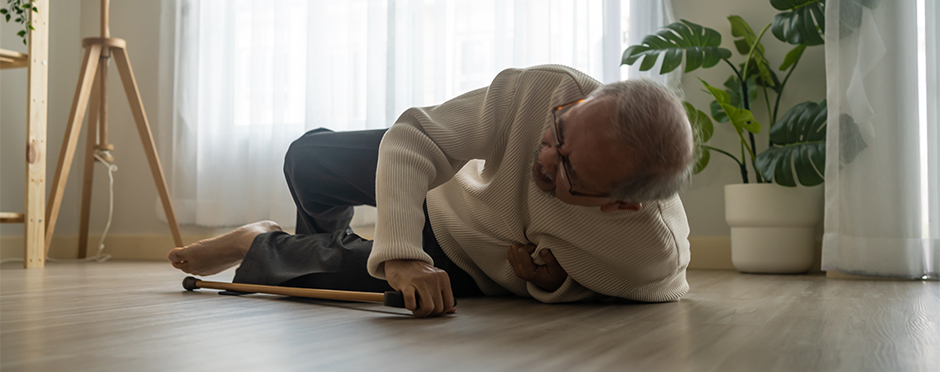
Fall Prevention for a Loved One Who Lives Alone
1 CommentDo you have a loved one who is a little unsteady on their feet, has a history of falls, or is too “stubborn” to use a cane or rolling walker? Here is a quick list of tips to help keep their home as safe as possible.
Safety Tips for Fall Prevention
- Clear a path – It is important to remove any unnecessary items from the floor. Some items such as throw rugs, toys, laundry items, decorations, trash, or exposed cords can act as tripping hazards and should be removed if possible. Small pets and children can often pose the same risk, so it is important to optimize free walking space and ensure play is performed in designated areas of the home.
- Night lights – These are great tools to help avoid trips and falls over unseen objects, animals/pets, or even help patients discriminate from shadows/objects. They can be placed at any outlet, in the toilet bowl, or even at countertop height to improve an individual’s perception of their environment.
- Highlighting Door Frames – Individuals with diminished vision can benefit from using neon/reflective tape around frequently used doorways to avoid accidental bumps/crashes that can result in falls. Conditions such as stroke, macular degeneration, and cataracts benefit from high contrast conditions to ensure safety. Be sure to evaluate the living space and do not place dark-colored chairs on dark carpets or vice versa; to truly reduce fall risk, the individual must be able to perceive all parts of their environment.
- Frequent Check-ins – Daily, weekly, and even monthly check-ins can be crucial in treating proactive and reactive fall cases. Fatigue, illness, and stress can also increase the risk of falls. It is important to ensure your loved one is healthy, has appropriate nutrition, and has all the necessary resources to succeed within their environment. I also recommend having an emergency action plan, reserve resources, and various contacts involved to maximize the individual’s safety and reduce the burden of one “provider” for this individual.
- Use of Cameras – Although it may be seen as a privacy violation, utilizing baby cameras aimed at the floor in high-traffic areas can help give family members and loved one’s peace of mind while providing the individual with their independence. This can also be performed in stairwells or outdoor areas with a higher risk of falls. Talk with your loved one and come up with a plan that you both agree to keep you both safe, happy, and healthy together.
- Life Alert or cell phones/smart watches – It may not be ideal to hire 24/7 help for a loved one, but tools such as life alert, cell phones, and smartwatches can act as guardian angels in the event of an emergency. Often the fall itself may not cause severe injuries, but the inability to get help promptly can truly set an individual back. These technological advances can help get individuals the support they need, conscious or unconscious. It should be noted that these tools only work when appropriately utilized. Individuals often remove them for activities such as “showering” or “doing errands”; please read the manufacturer’s guidelines and wear them as often as possible to reap the benefits.
- Bathroom safety – Installing grab bars, raised toilet seats, commodes, shower chairs, or tub benches are often the first line of defense in the bathroom. However, there are a few “free” ways to help. Keep the area dry, clean, and well-lit, and minimize the use of floor mats. It is also advisable to ensure proper space for the individual, adaptive equipment, and mobility to occur in this small space.
- Use of additional seating/support systems – If your loved one fatigues easily, it is advisable to place a chair in a safe place at the top/bottom of a stairwell to allow for safe rest breaks. It is also recommended to put an extra chair in the kitchen to allow for seated meal preparation, if appropriate. Should your home be multiple levels, placing a cane or rolling walker on each floor and in your vehicle to maximize usage of the device and mitigate any fall risk is advisable.
Keeping your loved one safe, healthy, and happy
I hope this list highlights a few simple solutions to help you and your loved one stay safe, healthy, and happy together. For a more patient-specific and individualized plan, please reach out to Athletico and set up an evaluation with your loved one. Remember, the relationship with your loved one should be family-focused and leave the stress of fall risk and fall prevention with us providers to address.
The Athletico blog is an educational resource written by Athletico employees. Athletico bloggers are licensed professionals who abide by the code of ethics outlined by their respective professional associations. The content published in blog posts represents the opinion of the individual author based on their expertise and experience. The content provided in this blog is for informational purposes only, does not constitute medical advice and should not be relied on for making personal health decisions.

1 Comment
Avleen Hanna
This is very easy to understand and hopeful!